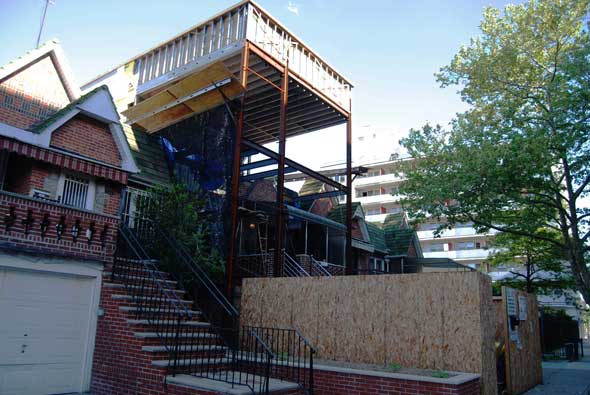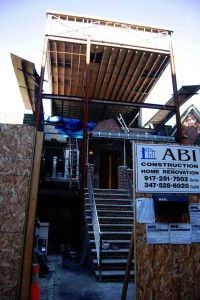Corbin Place Home A “Tumor”, Blame The City

Corbin Place is one of those rare streets in our neighborhood where all the homes look eerily similar, built around the same era, and have a lot of identical features. They all have garages, driveways, porches – even a bit of landscaping in most cases. Walking down the block, you might get the idea that someone actually planned something in this city.
But then 156 Corbin Place has to go and screw it up.
“This is something sticking out like a tumor or something,” a neighbor told us about the construction.
Look at this monstrosity! This is one of those fantastic examples of how New York City zoning laws fail – epically – at taking into account how neighborhoods are actually developed. This construction site may be a giant middle finger extended to neighbors, but as far as we can tell, it’s totally legal.
Zoned for R6, the owners are building out to the maximum height allowable, even though nearly all the homes on the block are one story less. And say goodbye to the sweet front-porches – as you can see in the photo, they’re extending the front of the house forward to make maximum use of the land.
Now, we understand the idea of property ownership, and though it may be inconsiderate, an owner has every right to expand his property within the law to better accommodate his family. Why blame them?
Here, the failing is with the city. This block happens to be in an area that mandates contractors to follow “Quality Housing Progam” (QHP) guidelines. At least that’s what’s indicated in the job filing. Here’s a blurb about the program:
[QHP] encourages development consistent with the character of many established neighborhoods. Its bulk regulations set height limits and allow high lot coverage buildings that are set at or near the street line. Quality Housing buildings must also have amenities relating to the planting of trees, landscaping and recreation space.
So there’s a nice attempt, in theory, to protect the character of the block. That’s why they can’t build all the way to the property line – they need to preserve the driveway space to match the other houses on the street.
But it doesn’t work. Boy, does it not work. Though the QHP blurb mentions trees, landscaping and recreation space, the actual guidelines refer to space space around the building, size of indoor recreational area, “windows are required” (!!), and the planting of, um, a tree. Except for the tree (!!), there’s really very little that protects the look and feel of the neighborhood – most of the rules seem to deal with the interior of the house. Which seems backwards, since the outside of the house is what mainly contributes to the character of a neighborhood.
So another ineffectual law dictated from Manhattan-based wonks sits on the books. Meanwhile, local communities who have to live with these phallic monuments to poor planning, who bought into a neighborhood because of its feel, and who know which architectural elements define their block’s identity, get no say in the look and feel of their community.
So, residents of Corbin Place prepare to say goodbye porches, goodbye landscaped driveway dividers, and heck, those brick exteriors have got to go. The city doesn’t think these things contribute to the character of your block.
Instead, get ready to say, “Hello, tumors!”




